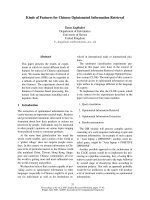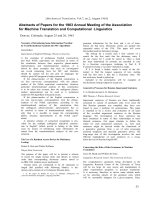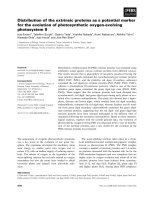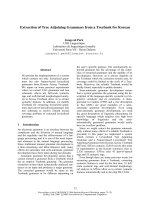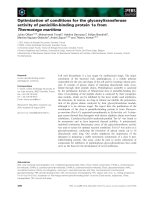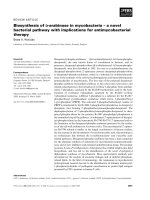báo cáo khoa học: " Efficacy of acupuncture for cocaine dependence: a systematic review & meta-analysis" pot
Bạn đang xem bản rút gọn của tài liệu. Xem và tải ngay bản đầy đủ của tài liệu tại đây (283.7 KB, 6 trang )
BioMed Central
Page 1 of 6
(page number not for citation purposes)
Harm Reduction Journal
Open Access
Research
Efficacy of acupuncture for cocaine dependence: a systematic
review & meta-analysis
Edward J Mills*
1,2
, Ping Wu
1,3
, Joel Gagnier
4
and Jon O Ebbert
5
Address:
1
Department of Clinical Epidemiology, Canadian College of Naturopathic Medicine, North York, Ontario, Canada,
2
Department of
Clinical Epidemiology & Biostatistics, McMaster University, Hamilton, Ontario, Canada,
3
London School of Hygiene & Tropical Medicine,
University of London, London, UK,
4
Institute of Medical Sciences, University of Toronto, Toronto, Ontario, Canada and
5
Department of Internal
Medicine, Mayo Clinic College of Medicine, Rochester, Minnesota, USA
Email: Edward J Mills* - ; Ping Wu - ; Joel Gagnier - ;
Jon O Ebbert -
* Corresponding author
Background: Acupuncture is a commonly used treatment option for the treatment of addictions
such as alcohol, nicotine and drug dependence. We systematically reviewed and meta-analyzed the
randomized controlled trials of acupuncture for the treatment of cocaine addiction.
Methods: Two reviewers independently searched 10 databases. Unpublished studies were sought
using Clinicaltrials.gov, the UK National Research Register and contacting content experts. Eligible
studies enrolled patients with the diagnosis of cocaine dependence of any duration or severity
randomly allocated to either acupuncture or sham or other control. We excluded studies of
acupuncture methods and trials enrolling patients with polysubstance use or dependence. We
abstracted data on study methodology and outcomes. We pooled the studies providing
biochemical confirmation of cocaine abstinence.
Results: Nine studies enrolling 1747 participants met inclusion criteria; 7 provided details for
biochemical confirmation of cocaine abstinence. On average, trials lost 50% of enrolled participants
(range 0–63%). The pooled odds ratio estimating the effect of acupuncture on cocaine abstinence
at the last reported time-point was 0.76 (95% CI, 0.45 to 1.27, P = 0.30, I
2
= 30%, Heterogeneity P
= 0.19).
Conclusion: This systematic review and meta-analysis does not support the use of acupuncture
for the treatment of cocaine dependence. However, most trials were hampered by large loss to
follow up and the strength of the inference is consequently weakened.
Introduction
Recent research on cocaine abuse and its treatment are
consistent in the estimates of the social, physical, emo-
tional and financial costs attributed to this addiction [1-
5]. Currently, there is no specific pharmacologic, behavio-
ral, or psychosocial therapy that has consistently demon-
strated treatment benefits[6,7]. Most current treatment
approaches are extensions of treatments ordinarily
applied to alcohol or opiate addiction[8]. The limited suc-
cesses in treating cocaine addiction have led patients and
clinicians to examine alternative approaches.
Published: 17 March 2005
Harm Reduction Journal 2005, 2:4 doi:10.1186/1477-7517-2-4
Received: 03 June 2004
Accepted: 17 March 2005
This article is available from: />© 2005 Mills et al; licensee BioMed Central Ltd.
This is an Open Access article distributed under the terms of the Creative Commons Attribution License ( />),
which permits unrestricted use, distribution, and reproduction in any medium, provided the original work is properly cited.
Harm Reduction Journal 2005, 2:4 />Page 2 of 6
(page number not for citation purposes)
Acupuncture is one such treatment option for addictions
such as alcohol, nicotine and drug dependence[9,10].
Currently, more than 500 clinics in the United States,
Canada and Europe, as well as several court-related pro-
grams, include acupuncture as a treatment option for drug
dependence[11]. However, to date, the effectiveness of
acupuncture as a primary treatment option or as an
adjunct for cocaine dependence remains uncertain. The
aim of our study was to conduct a systematic review and
meta-analysis of randomized controlled trials assessing
the impact of acupuncture on cocaine dependence.
Methods
Inclusion/Exclusion Criteria
Eligible studies enrolled patients with the diagnosis of
cocaine dependence of any duration or severity randomly
allocated to either acupuncture, sham or other control.
Acceptable outcomes measures included: self-reported
frequency of cocaine use, self-reported amount of cocaine
use, or biochemical confirmation of cocaine abstinence.
Biochemical confirmation of cocaine abstinence is
defined as the absence of the cocaine metabolite ben-
zoylecognine in the urine. We excluded trials of acupunc-
ture methods and trials enrolling patients with
polysubstance use or dependence.
Literature search
Databases searched included: AMED (1985–November
2004), Campbell Collaboration (2001–January 2005),
CINAHL (1982–January 2005), Cochrane Library (1998–
January 2005), Cochrane Controlled Trials Registry (Janu-
ary 2005), E-Psyche (1993–January 2005), HTA (1988–
January 2005), and MEDLINE (1966–January 2005). We
additionally searched the Chinese literature through Wan-
fang (1997–January 2004) and the Chinese Hospital
Knowledge Database (CHKD, 1994–2004). Unpublished
studies were also sought using Clinicaltrials.gov and the UK
National Research Register. We supplemented this search
by hand-searching key journals and searching bibliogra-
phies of retrieved trials and reviews. We additionally con-
tacted 5 authors to identify additional published or
unpublished studies and to clarify methodological issues.
There were no language restrictions.
Two reviewers (EM, PW) working independently and in
duplicate, reviewed the abstracts and full text versions of
identified reports and adjudicated their inclusion.
Data extraction
Three reviewers (PW, EM, JG) working independently
extracted data from the included studies using a standard-
ized form which included: patient characteristics, treat-
ment and control descriptions, types of outcomes
measured, adverse events, and study results.
Methodological reporting
Two reviewers (EM, PW) working independently and in
duplicate assessed the reporting quality of the reports.
Items collected included randomization procedure, allo-
cation concealment, blinding of patients, care providers,
and outcome assessors, adequate description of loss to
follow-up, and co-interventions. These items were treated
as single items and were abstracted for the purpose of sen-
sitivity analyses in our meta-analysis, but were not used as
a weighting application in our analysis.
Statistical analyses
We measured chance-adjusted inter-rater agreement for
eligibility using the kappa statistic (κ). Where reported, we
extracted each trial's outcome data from the intention-to-
treat analyses. If biochemical confirmation of cocaine
abstinence was not reported, we contacted the authors for
details. When a study had more than one control arm, we
used the sham acupuncture arm as the control group. We
pooled the rates of biochemically-confirmed cocaine
abstinence in intervention and control groups across
included trials using a random-effects meta-analysis and
report the results using a forest plot describing the odds
ratios (OR) and 95% confidence intervals (CI) at last
reported time point. A priori explanations of between-
study differences beyond chance included reporting of
allocation concealment, use of intention-to-treat analyses,
and large loss to follow-up (>50%). We tested for hetero-
geneity using the Zalen test and measured the proportion
of between-study differences not attributable to chance
with the I
2
statistic[12]. Our secondary analysis consid-
ered all drop outs as treatment failures. All statistics were
performed using StatsDirect (Manchester, 2003).
Results
The search yielded 83 relevant abstracts (Figure 1). Of
these, 20 were retrieved for potential inclusion, four stud-
ies were not randomized controlled trials [13-16], four
studies investigated methodological issues in acupuncture
trials [17-20], 2 included polysubstance abusers[13,21]
and one investigated pharmacothearapy[22]. Table 1
describes the 9 trials included in the final analysis (See
additional file 1). Chance-adjusted inter-rater agreement
was high (κ = 0.96, 95% CI 0.91 to 1) [23-31].
Study characteristics
The 9 RCTs were conducted in the USA and included 1747
participants: 488 participants in active groups and 821
assigned to control groups (One RCT did not describe
group sizes[25]).
One RCT included only crack cocaine users[27], 5 RCTs
included samples with mixed forms of cocaine abuse (eg.
intravenous, inhaled, or intranasal) and 3 RCTs did not
describe the type of cocaine or the route of
Harm Reduction Journal 2005, 2:4 />Page 3 of 6
(page number not for citation purposes)
administration[26,29,31]. RCTs enrolled participants
with different rates of anti-craving medication use and 3
RCTs included only patients using methadone in addition
to cocaine[23,26,31]. Three RCTs enrolled some patients
using methadone[24,27,28], 2 RCTs excluded patients
who used methadone[25,29] and 1 did not report the use
of anti-craving medication among enrolled subjects[30].
All 9 trials employed auricular acupuncture, 4 employed a
specific auricular acupuncture regimen (National Acu-
puncture Detoxification Association: NADA) and 2 used a
combination of auricular and body points. Five trials had
more than 1 control group [24-26,28,31]or randomized
subjects to receive methods including relaxa-
tion[26,28,31], anti-craving medication and brainwave
modification[24], or psychosocial treatment[25].
Eight trials used urine assays for cocaine metabolites (ben-
zoylecgonine) for biochemical confirmation of absti-
nence at follow-up; we were able to obtain results from 7
of them. Eight trials examined the likelihood of retaining
patient participation in the trial, and 5 trials examined
cocaine cravings; no trials reported participant follow-up
or relapse.
Reporting quality of manuscripts
Although all trials were randomized, only 4 trials
described the randomization technique[26,28,30,31].
Two trials employed restriction to balance the
groups[26,28]. Allocation concealment was not ade-
quately reported in any study. Information regarding acu-
puncture technique needle depth and needle type was
present in 3 trials[23,26,29]. Methods of inserting a sham
Study identification for a Systematic Review of Acupuncture for Cocaine DependenceFigure 1
Study identification for a Systematic Review of Acupuncture for Cocaine Dependence.
83 abstracts screened for
inclusion
20 publications retrieved for
potential inclusion
9 articles included in review
63 abstracts excluded as irrelevant or
review articles/commentaries
11 publications excluded.
•
Not randomized (n = 4)
• Methodologic investigations (n = 4)
•
Included polysubstance abusers (n = 2)
•
Included pharmacotherapy (n = 1)
Harm Reduction Journal 2005, 2:4 />Page 4 of 6
(page number not for citation purposes)
needle as a control were used in 8 trials[23,25-31]. Five
trials reported more than 20% loss to follow-up (mean
loss to follow-up across all trials was 50% [range, 0–
63%])[25,26,28-30]. Only 4 trials described reasons for
withdrawals[25,26,28,29].
Meta-analysis
We pooled results from 7 trials that reported biochemical
confirmation of cocaine abstinence. The pooled odds
ratio estimating the effect of acupuncture on cocaine
abstinence was 0.76 (95% CI 0.45–1.27, P = 0.3, I
2
= 30%,
Heterogeneity P = 0.19) at the last reported time point
(range 4–12 weeks) (see figure 2). Our a priori hypotheses
failed to explain the heterogeneity that was present. That
is, for each a priori explanation, the magnitude of the effect
differed little irrespective of the level of the hypothesized
explanatory factor. Our secondary analysis, considering
all dropouts as treatment failures, resulted in a pooled
odds ratio of 0.76 (95% CI, 0.54–1.08), P = 0.12, I
2
= 0%,
Heterogeneity P = 0.5).
Adverse effects reported included pain and fear of nee-
dles[23,26,28,29,31] No trials reported the proportion of
participants suffering adverse effects.
Discussion
Statement of findings
This systematic review and meta-analysis does not sup-
port the use of acupuncture for the treatment of cocaine
dependence. However, most trials were hampered by
large loss to follow up and the strength of the inference is
consequently weakened.
Meta-analysis of 7 trialsFigure 2
Meta-analysis of 7 trials.
Odds ratio meta-analysis plot [random effects]
0.001 0.01 0.1 0.2 0.5 1 2 5 10 100
Margolin (b) 0.682 (0.081, 5.852)
Margolin 0.679 (0.332, 1.382)
Avants (b) 1.333 (0.253, 7.138)
Bullock 0.843 (0.412, 1.722)
Richard 0.268 (0.076, 0.925)
Avants 3.792 (0.628, 24.390)
Lipton 0.333 (0.005, 8.604)
combined [random] 0.764 (0.458, 1.276)
odds ratio (95% confidence interval)
Harm Reduction Journal 2005, 2:4 />Page 5 of 6
(page number not for citation purposes)
Strengths and weaknesses
We minimized publication bias by conducting an exten-
sive search through multiple databases, including Chi-
nese-language databases. We successfully received original
data from several authors. We also sought to minimize
selection and ascertainment bias by including only rand-
omized controlled trials with biochemical confirmation
of abstinence in our meta-analysis. However, large loss to
follow-up and unexplained inconsistency across the
included trials weakens our inferences.
The conduct of explanatory trials to ascertain the efficacy
of acupuncture for cocaine addiction is challenging. We
do not know whether there is a group of patients more
likely to respond to this intervention who will agree to
take part and stay enrolled in a clinical trial with adequate
duration of follow-up. Pragmatic trials enrolling heteroge-
neous patients need to be large enough to detect small
treatment effects and should be conducted according to
the intention-to-treat principle to avoid large loss to fol-
low-up. However, we recognize the difficulty of enrolling
and maintaining patients who use or are dependent on
cocaine in an RCT. Design strategies to maintain patients
enrolled in trials of cocaine addiction treatment represent
a research frontier.
Blinding of participants in a clinical trial is important
because knowledge of group assignment may influence
responses to treatment[32]. Use of sham controls and
blinding of patients may prevent bias. The sham acupunc-
ture method has been an area of debate as it is difficult to
determine if a needle inserted into the skin away from des-
ignated acupuncture points is inert[20,33]. In this system-
atic review, 8 trials applied sham acupuncture in the
control groups[23,25-31], 3 of which used the NADA
technique for acupuncture protocol and these trials found
inconsistent results[26,28,31]. Three trials also used a
similar 5-point acupuncture protocol and did not find a
significant effect[25,27,29].
We identified one additional systematic review of acu-
puncture for cocaine addiction which is in the process of
data collection for a Cochrane review, and worked collab-
oratively with the primary investigator [S. Gates, personal
communication]. We found systematic reviews assessing
the efficacy of acupuncture in patients abusing other sub-
stances (nicotine[10], alcohol and heroin[6,9]). Our find-
ings are consistent with these other reviews in that they
included trials with large loss to follow-up and were una-
ble to draw strong inferences about the efficacy of acu-
puncture as a single intervention in the management of
substance abuse.
At present, no proven pharmacotherapies exist for cocaine
dependence[8,34,35]. Current psychosocial strategies
may only be effective in select patients with stable living
conditions and social support and meta-analyses of these
interventions are ongoing[6,36]. However, a lack of proof
of efficacy does not indicate a lack of efficacy, and the data
are dramatically hampered by dropouts. In treatment
environments wishing to use multimodality therapy, acu-
puncture may be used for treatment of cocaine depend-
ence since it is a relatively safe intervention and may be in
line with patient values and cultural experiences. How-
ever, in resource-constricted environments, the use of acu-
puncture for cocaine dependence is not justified with the
current evidence.
Conclusion
Our systematic review and meta-analysis yielded incon-
clusive data about the effect of acupuncture. The best esti-
mate of effect is consistent with no treatment effect.
Initiatives, such as court mandated programmes, which
recommend acupuncture for cocaine dependence, are not
supported by the available evidence.
Authors' contributions
Edward Mills developed the protocol, conducted the
search and study selection, worked at data abstraction and
quality rating and wrote the manuscript.
Ping Wu conducted the search and study selection,
worked on data abstraction and quality rating, and ana-
lyzed the data.
Joel Gagnier worked at data abstraction and wrote the
manuscript.
Jon Ebbert provided critical revision and writing of the
manuscript.
We greatly appreciate the advice and contributions of Dr.
Victor M. Montori
Competing interests
The author(s) declare that they have no competing
interests.
Additional material
References
1. Cartwright WS: Cocaine medications, cocaine consumption
and societal costs. Pharmacoeconomics 2000, 18:405-413.
Additional File 1
Table 1. Characteristics and findings of included studies
Click here for file
[ />7517-2-4-S1.doc]
Publish with Bio Med Central and every
scientist can read your work free of charge
"BioMed Central will be the most significant development for
disseminating the results of biomedical research in our lifetime."
Sir Paul Nurse, Cancer Research UK
Your research papers will be:
available free of charge to the entire biomedical community
peer reviewed and published immediately upon acceptance
cited in PubMed and archived on PubMed Central
yours — you keep the copyright
Submit your manuscript here:
/>BioMedcentral
Harm Reduction Journal 2005, 2:4 />Page 6 of 6
(page number not for citation purposes)
2. Ogunyemi D, Hernandez-Loera GE: The impact of antenatal
cocaine use on maternal characteristics and neonatal
outcomes. J Matern Fetal Neonatal Med 2004, 15:253-259.
3. Gunnarsson M, Fahlke C, Balldin J: [Adolescents who have tried
illicit drugs and experienced psychiatric symptoms seldom
seek professional help. A pilot study of 18-year old high
school students in an urban district]. Lakartidningen 2004,
101:1280-1282.
4. Nebelsieck H: [Recreational and designer drugs-the risks to
heart and brain]. MMW Fortschr Med 2004, 146:40-42.
5. Ribeiro M, Dunn J, Laranjeira R, Sesso R: High mortality among
young crack cocaine users in Brazil: a 5-year follow-up study.
Addiction 2004, 99:1133-1135.
6. van den Brink W, van Ree JM: Pharmacological treatments for
heroin and cocaine addiction. Eur Neuropsychopharmacol 2003,
13:476-487.
7. Cochrane C, Malcolm R, Brewerton T: The role of weight control
as a motivation for cocaine abuse. Addict Behav 1998,
23:201-207.
8. de Lima MS, de Oliveira Soares BG, Reisser AA, Farrell M: Pharma-
cological treatment of cocaine dependence: a systematic
review. Addiction 2002, 97:931-949.
9. Ter Riet G, Kleijnen J, Knipschild P: A meta-analysis of studies
into the effect of acupuncture on addiction. Br J Gen Pract 1990,
40:379-382.
10. White AR, Rampes H, Ernst E: Acupuncture for smoking
cessation. Cochrane Database Syst Rev 2002:CD000009.
11. SAMSHA.: Substance Abuse and Mental Health Services
Administration, Uniform Facility Data Set
(UFDS):1999:DHHS Publication no. (SMA) 99-3314;2000. .
12. Higgins JP, Thompson SG: Quantifying heterogeneity in a meta-
analysis. Stat Med 2002, 21:1539-1558.
13. Konefal J, Duncan R, Clemence C: The impact of the addition of
an acupuncture treatment program to an existing metro-
Dade County outpatient substance abuse treatment facility.
J Addict Dis 1994, 13:71-99.
14. Rossano NA: Crack/cocaine abuse acupuncture as an effective
adjunct to therapy in current treatment programs. Interna-
tional Journal of Clinical Acupuncture 1992, 3:333-338.
15. Killeen TK, Brady K: A preliminary study of the effects of auric-
ular acupuncture on alcohol and drug withdrawal symptoms.
Substance abuse 1997, 18:119-124.
16. Margolin A, Avants SK, Kleber HD: Investigating alternative
medicine therapies in randomized controlled trials. Jama
1998, 280:1626-1628.
17. Margolin A, Avants SK, Birch S, Falk CX, Kleber HD: Methodologi-
cal investigations for a multisite trial of auricular acupunc-
ture for cocaine addiction: a study of active and control
auricular zones. J Subst Abuse Treat 1996, 13:471-481.
18. Margolin A, Avants SK, Chang P, Birch S, Kosten TR: A single-blind
investigation of four auricular needle puncture
configurations. Am J Chin Med 1995, 23:105-114.
19. Margolin A, Avants SK, Kleber HD: Rationale and design of the
Cocaine Alternative Treatments Study (CATS): a rand-
omized, controlled trial of acupuncture. J Altern Complement
Med 1998, 4:405-418.
20. Margolin A, Chang P, Avants SK, Kosten TR: Effects of sham and
real auricular needling: implications for trials of acupuncture
for cocaine addiction. Am J Chin Med 1993, 21:103-111.
21. Wells EA, Jackson R, Diaz R, Stanton V, Saxon AJ, Krupski A: Acu-
puncture as an adjunct to methadone treatment services.
American Journal on Addictions 1995, 4:198-214.
22. Margolin A, Avants SK: Should cocaine-abusing, buprenor-
phine-maintained patients receive auricular acupuncture?
Findings from an acute effects study. J Altern Complement Med
1999, 5:567-574.
23. Avants SK, Margolin A, Chang P, Kosten TR, Birch S: Acupuncture
for the treatment of cocaine addiction. Investigation of a
needle puncture control. J Subst Abuse Treat 1995, 12:195-205.
24. Richard AJ, Montoya ID, Nelson R, Spence RT: Effectiveness of
adjunct therapies in crack cocaine treatment. J Subst Abuse
Treat 1995, 12:401-413.
25. Bullock ML, Kiresuk TJ, Pheley AM, Culliton PD, Lenz SK: Auricular
acupuncture in the treatment of cocaine abuse. A study of
efficacy and dosing. J Subst Abuse Treat 1999, 16:31-38.
26. Avants SK, Margolin A, Holford TR, Kosten TR: A randomized
controlled trial of auricular acupuncture for cocaine
dependence. Arch Intern Med 2000, 160:2305-2312.
27. Killeen TK, Haight B, Brady K, Herman J, Michel Y, Stuart G, Young
S: The effect of auricular acupuncture on psychophysiological
measures of cocaine craving. Issues in Mental Health Nursing 2002,
23:445-459.
28. Margolin A, Kleber HD, Avants SK, Konefal J, Gawin F, Stark E,
Sorensen J, Midkiff E, Wells E, Jackson TR, Bullock M, Culliton PD,
Boles S, Vaughan R: Acupuncture for the treatment of cocaine
addiction: a randomized controlled trial. Jama 2002, 287:55-63.
29. Otto KC, Quinn C, Sung YF: Auricular acupuncture as an
adjunctive treatment for cocaine addiction. A pilot study. Am
J Addict 1998, 7:164-170.
30. Lipton DS, Brewington V, Smith M: Acupuncture for crack-
cocaine detoxification: experimental evaluation of efficacy. J
Subst Abuse Treat 1994, 11:205-215.
31. Margolin A, Avants SK, Holford TR: Interpreting conflicting find-
ings from clinical trials of auricular acupuncture for cocaine
addiction: does treatment context influence outcome? J Altern
Complement Med 2002, 8:111-121.
32. Schulz KF, Chalmers I, Hayes RJ, Altman DG: Empirical evidence
of bias. Dimensions of methodological quality associated
with estimates of treatment effects in controlled trials. Jama
1995, 273:408-412.
33. Park J, White AR, Ernst E: New sham method in auricular
acupuncture. Arch Intern Med 2001, 161:894; author reply 895.
34. Lima AR, Lima MS, Soares BG, Farrell M: Carbamazepine for
cocaine dependence. Cochrane Database Syst Rev 2002:CD002023.
35. Lima MS, Reisser AA, Soares BG, Farrell M: Antidepressants for
cocaine dependence. Cochrane Database Syst Rev 2003:CD002950.
36. Soares BG, Lima MS, Farrell M: Psychosocial treatments for psy-
chostimulants dependence (Protocol). Cochrane Drugs and Alco-
hol Group, Cochrane Database of Systematic Reviews 2004, 4:.
